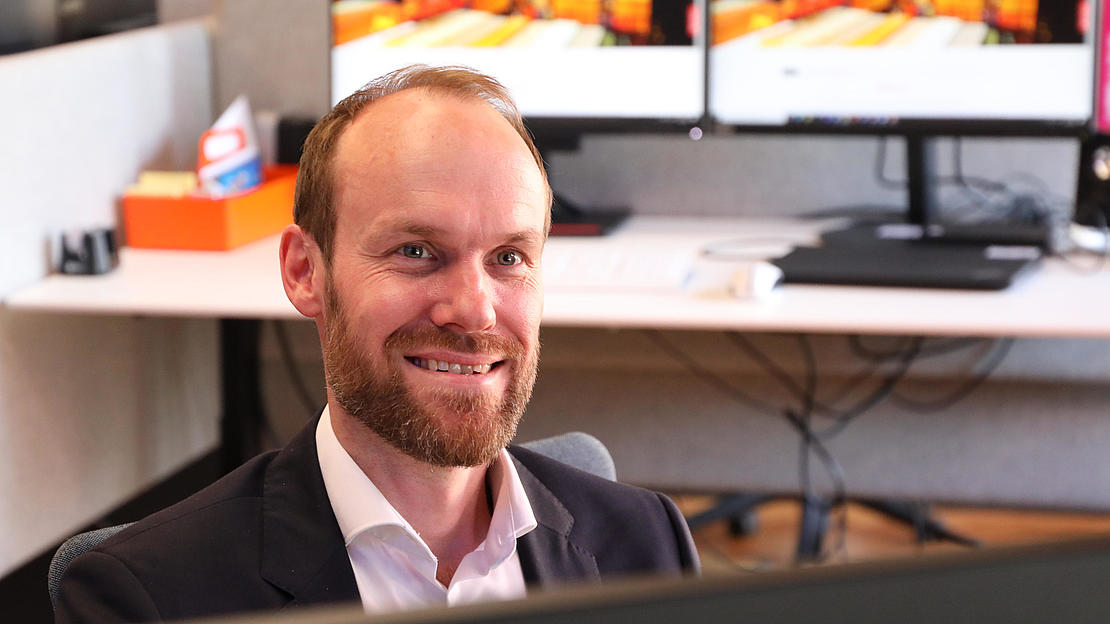The data carrier
Sönke Witt heads HHLA’s business partner communication and is co-chairman of the Ship Message Design Group (SMDG). His work revolves around data standardisation, networking and quality. The only way to continue improving the logistics system as a whole is by optimising the exchange of data.

Sönke Witt has an impressive job description that he is not entirely happy with. Though he is the Head of Business Partner Communication at HHLA, “It should be Business Partner DATA Communication,” he says. “However, the title is already too long, and we haven’t managed to come up with anything better.”
Not to give a false impression: Sönke Witt is not the kind of person to be defined by his title. The industrial engineer specialises in transport management and has worked for HHLA since 2004. His concern is accuracy, which plays a big role in his profession. This revolves around the complex topic of transport data, which refers to the numbers and information generated when a container is moved. If these are not correct, there may be consequences.
An example of the effect that incorrect data can have is the weight of a container. If the values entered into a ship’s storage plan are too low, there is a risk of the cargo sliding in rough seas. For this reason, container weight was included as a so-called VGM in the sets of standardised data formats some time ago.
We have created useful standards; now we need to improve the quality of the data.
One of these sets of standardised data formats, BAPLIE, is repeatedly sent back and forth between the shipping company, the terminal and the ship’s captain for container handling. In the process, all information that ship planners, dispatchers and crew need to “properly” store a container on board the ship is collected.
BAPLIE is considered the basis for the foundation of the Ship Message Design Group (SMDG), a sub-organisation of the United Nations (UN). HHLA has been included since it was founded in 1987. Today, Sönke Witt is one of its two chairpersons. In this role, he travels the world to build networks between the partners and exchange experiences.
In the meantime, the SMDG has developed and modernised many standards in order to simplify data communication, especially between port terminals and carriers. “When a container is supposed to get priority, we sometimes still get urgent calls from the shipping company,” says Witt. “But in the vast majority of cases, we get the loading and unloading information through EDIFACT.”
Another abbreviation, of which there are many in Sönke Witt’s day-to-day work. The special language that IT specialists use for interface design is behind EDIFACT, which was defined as a sub-organisation of the UN by UNECE. Though only 55 countries are represented in EDIFACT, logistics specialists around the world rely on its standards.
This allows their different data systems to communicate with each other. Given that nearly everything in the transport industry is planned using highly complex software, a common language is needed. One example is the handling of hazardous goods containers, of which there are many. Specific places are designed for them on ships and in container yards. Transhipment of these special containers requires that their weight and the nearest charging stations be taken into account. And to ensure that their transhipment is as efficient as possible, the containers must be arranged in an optimal sequence.
Yet terminals and shipping companies are only a small part of the transport chain, and BAPLIE is a tiny section of the connected data system. At the port alone, the ATLAS customs system, the Port Community System and the port railway’s transport rail all enter the picture.
“In Hamburg, we have a well-functioning network of all these data suppliers,” says Witt. “However, optimisation of the logistics system as a whole still requires the creation of important interfaces and improved communication.” As an example, he mentions that the European rail network and railway companies are not nearly as far along as the maritime sector.
Yet Witt doesn’t want to point fingers at others’ weaknesses: there is still also plenty to do at HHLA and in the port. “We have created useful standards; now we need to improve the quality of the data.”
Data is an efficient – but not always the most effective – means of communication. Above all, people need to talk a lot, and not just with the shipping companies. Witt says: “If we manage to convince all the transport partners of the advantages of comprehensive data communication, our entire logistics system will make another huge leap towards increased reliability and more predictability.”
Curious about us?
They have a lot to say – from the port, from the past, from their day-to-day work or from abroad.
Read more